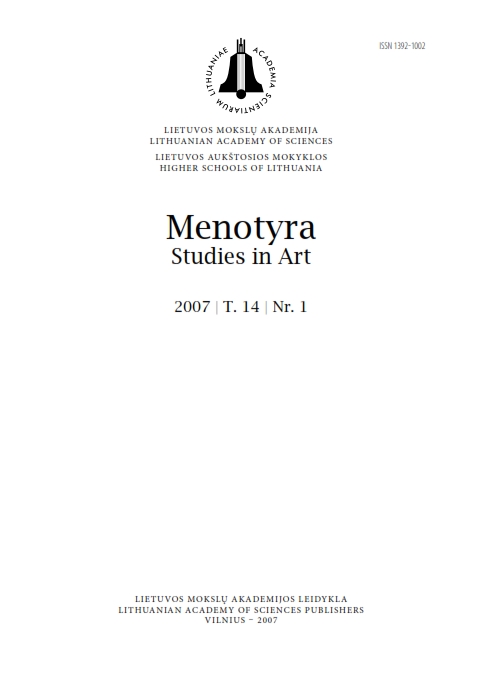Mindaugo Urbaičio muzika kino filmams (1976–2002)
Mindaugas Urbaitis’ music for movies
Author(s): Saulius GerulisSubject(s): Music, Film / Cinema / Cinematography
Published by: Lietuvos mokslų akademijos leidykla
Summary/Abstract: Mindaugas Urbaitis’ music for movies is analysed historically, i. e. what, where, how it was created, whom the composer cooperated with, etc. The focus is laid on the analysis of the scores style, its basic source being the composer’s manuscripts.M. Urbaitis made his debut as a movie composer in 1976. It was the year after graduating from Professor Julius Juzeliūnas’ composition department of the Conservatoire (now Lithuanian Music and Theatre Academy). The first score was written for the documentary “Paths Close to Highways” directed by Edmundas Zubavičius. Due to the meager movie budget it was a short ten-page hand-written piece of music. Considering its compositional technique, the score did not reveal any novelties – elegiac tones, limpid textures had formed in the other genres of the early composer’s music.The following project was of a larger scope – music for the movie after the three-part drama “Barbora Radvilaitė” by Juozas Grušas (1982). It was a big work (director Vidmantas Bačiulis). The score consisted of 104 hand-written pages containing 24 musical episodes serving various purposes. Some of them accompanied and enriched the movie characters, the others filled in the insertions between the episodes. The core of the entire musical dramatic composition was dances. They turned into the symbols of the palace where the principal events were taking place. The dance melodies were based upon the motifs of an anonymous composer’s music piece.Subsequently, the composer created music for two animation movies, “The Tree” (1983) and “Tomorrow, at 11 a. m.” (1985) directed by Nijolė Valadkevičiūtė. These movies needed music of different character, nevertheless, the composer` s style remained unchanged – his minimalistic technique of creation dominated and was skilfully applied to the animation genre.At that time the composer was offered by director Vidmantas Bačiulis to work on the videomovie “Benjaminas Kordušas” after Justinas Marcinkevičius’ drama (its first run was on November 17, 1986). This movie was permeated with psychology. All the action was concentrated on the main hero played by Antanas Šurna. The director wanted music to strengthen the personal emotions of Benjaminas Kordušas. The movie score was extensive – 232 big format pages, the textures, however, were minimalistic, clear and thin-lined. It stands to reason as the year 1986 was the most radical minimalistic period even in other composer’s genres. Alongside the minimal compositional techniques, however, the composer started integrating re-composition which could be also traced in that movie. The motifs of the well-known M. K. Oginskis polonaise were used (recreated) there. Namely, the rhythm of that most popular Polonaise a-moll became a fulcrum for the movie concept. The polonaise with its Polish tunes emphasized the national identity of noblemen of that time.The further work was music for the three-part feature video movie “Vilius Karalius” after a novel by Ieva Simonaitytė. Once again the composer collaborated with director V. Bačiulis. The movie needed much more music than the previous one. The wider scope called for more themes. The score contained 328 big format pages. A Lithuanian folk song served as a starting point and conferred a peculiar colour to the entire music containing tunes of different character. The themes dramatizing war scenes sharply contrasted with lyric tunes (leittemes). The sounds of choral intonations could also be heard.The scores of both video movies, “Benjaminas Kordušas” and “Vilius Karalius”, were perfectly instrumented and their musical dramaturgy was thoroughly contemplated. It was apparent that M. Urbaitis had deeply considered distinctive laws of creative work, the specific nature of movie music and its exceptionality.Success with movie music gave a push to one more creative project. On February 17, 1992 the video movie “A Smashed Jug” after Heinrich von Kleist was cast on Lithuanian TV. That was a comedy accompanied by a little score of M. Urbaitis’ minimalistic music.After that work the composer made a stop in the field of movies. In a way, it was caused by the composer’s intensive social activity as in the period 1991–1996 he was President of the Lithuanian Composers’ Union.After ten years M. Urbaitis “came back” to the cinema. In July 2002 the composer worked on the score for the Lithuanian TV documentary “Kernavė Archeologists” (scriptwriter and director Gražina Basford). During the decade the composer`s aesthetics underwent some changes. A strong impact was made by computer technologies. Music for “Kernavė Archeologists” was created on computer. The instrumentation, however, was typical of the composer.This is a short review of the composer`s music for the movies. It possesses its own exceptional colour, manner, dramaturgy, i. e. its own style. This statement comes taking into consideration composer`s minimalistic features permeating his movie scores. The critics frequently refer to the moderate usage of musical expression means, trying to avoid contrasts, striving for creative lucidity, etc. It is evident that the number of opuses for movies cannot be compared with scores to theater perfomances which have been written 4–5 a year since composer`s Conservatoire days. Actually, this way of composition has its own advantages – M. Urbaitis has never yielded to routine and in some scores his movie music appears to be “fresher”, more emotional than in those dedicated to theater.
Journal: Menotyra
- Issue Year: 14/2007
- Issue No: 1
- Page Range: 45-60
- Page Count: 16
- Language: Lithuanian

